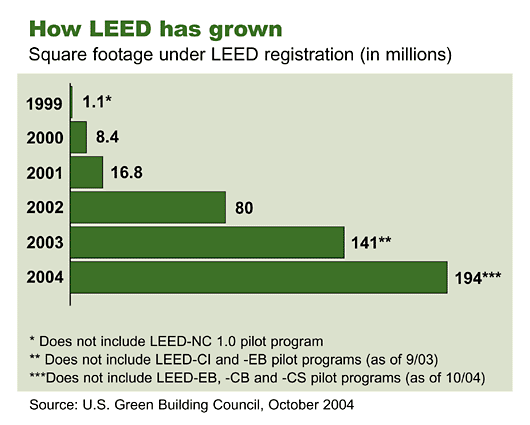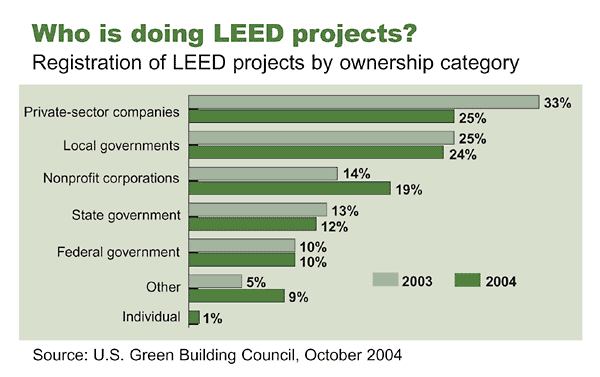Green Building on the Move
Editor’s Note – This article is an excerpt from "Progress Report on Sustainability" first published by Building Design & Construction in November 2004. Copyright 2004 Reed Business Information. All rights reserved.
2004 was a remarkable year for the green-building movement. It witnessed the birth of three new entities in the U.S Green Building Council’s Leadership in Energy and Environmental Design program. In addition to LEED for New Construction (NC), which has been in place for four years, 2004 has seen the launch of LEED for Existing Buildings (EB) and Commercial Interiors (CI), with yet a fourth program, LEED for Core & Shell (CS), well into the pilot phase. The successful development of these complex green-rating systems is a tribute to the hard work of their respective committees and the USGBC leadership.
LEED for Existing Buildings
The pilot program for LEED-EB was launched in January 2002, with 99 projects representing 31.5 million square feet of space taking part. Since then, nine projects have been certified, and on October 22, 2004, the balloted version was released.
The first thing to keep in mind about LEED-EB is that 75 percent or more of the lifetime costs of a building go into operations and maintenance. Existing buildings (including homes) consume nearly 40 percent of the nation’s energy; add 40 percent to its atmospheric emissions; consume 68 percent of its electricity, 12 percent of its fresh water, and 88 percent of its potable water; account for 40 percent of municipal solid waste; and use 40 percent of all wood and raw materials in U.S. construction.
The other thing to remember is that there are nearly 100 times as many existing commercial, industrial and institutional buildings than are built every year. Theoretically, then, greening existing buildings could have a couple of orders of magnitude greater impact on energy consumption and the environment than could be achieved greening new buildings.
That’s why LEED-EB is aimed chiefly at upgrading the operations and maintenance aspects of buildings. Thus, LEED-EB provides a way to recertify buildings that were first certified under either LEED-NC or LEED-EB. It also requires that buildings that have not been certified under LEED-NC be at least two years old before they can register with the program.
Many credits in LEED-EB emulate those in LEED-NC, but the key difference is EB’s emphasis on operations and maintenance. For example, a project can earn a point for each 30 percent of annual purchases of cleaning products that meet various green standards, such as Green Seal GS-37 (MR Credits 4.1-4.3). In fact, says EB Committee Chair Michael Arny, there are a number of "low-cost" points available for cleaning and maintenance materials. "A lot of what’s involved in operating a building in a sustainable way is not about capital expenditures, it’s about paying attention to procedures and purchases," he says.
LEED-EB could draw a whole new set of players to green building–facility managers. As companies begin to grasp the economic and environmental impact of their buildings (usually a firm’s biggest capital asset), senior management will start to see the value of having facility managers who are skilled in green building. Arny predicts that, in a few years, facility managers will make up the majority of those involved in green building and the USGBC.
LEED for Commercial Interiors
LEED-CI is intended for organizations that want to "green" their tenant space or commercial interiors. So, a law firm with two floors in an office building, or a retail store in a shopping mall, might fit out its space according to LEED-CI. It can be applied to new buildings, old buildings or buildings where tenants are remodeling. Since LEED-CI is devoted to tenant interior fit-outs, some credits found in other LEED programs, such as reducing water usage for irrigation, are not relevant. More than 90 projects, comprising 6.47 million square feet of space, participated in the pilot program, with 16 earning various levels of certification.
LEED-CI targets the selection of sustainable tenant space, efficient water usage by tenants, optimized energy performance (especially lighting and lighting controls), materials for interior building systems and furnishings (notably furniture, carpet and flooring), and indoor environmental quality (with an emphasis on controlling VOCs).
LEED-CI seems to have attracted a new cohort of LEED users. According to interior designer Keith Winn, project manager for LEED-CI, about 70 percent of the 90 or so projects in the LEED-CI pilot program were first-time users of LEED. These included construction, architectural/engineering and mechanical/engineering firms that were applying LEED-CI to their own buildings. "It’s not something we anticipated," he says. Building product manufacturers–makers of carpets, furniture, mechanical equipment, etc.–constituted another group. A third category included retail operations like Whole Foods, Kinko’s, Bank of America and Enterprise Rent-A-Car, which, according to Winn, might have been giving LEED-CI a tryout to see if it fit into their respective corporate values.
The committee was also surprised, after careful review of more than 20 submittals, at the wide disparity among engineering firms in their knowledge and understanding of ASHRAE standards for energy and indoor environmental quality. "They just haven’t had a lot of experience with [ASHRAE]," says Winn. "Maybe it’s not a requirement on their [non-LEED] projects, so they’re not up to date with what’s required or how to document it. That was an eye-opener."
LEED-CI also reflects the growing interest in "New Urbanism." SS Credit 2, formerly known as "Development Density," was renamed "Urban Redevelopment" to encourage tenants to select space in established, "walkable" communities or in neighborhoods with pedestrian access to at least 10 of 20 identified "basic services": banks, grocery stores, daycare centers, post offices, schools, hair salons, etc.
LEED-CI Chair Penny S. Bonda says the committee started out five years ago with hopes of making some fairly radical changes in LEED, including greater emphasis on life-cycle analysis and performance standards. "We were going to change the world," she says. But reality stepped in, and the committee had to pull back from its ambitious agenda, pending approval of revisions to the basic LEED format anticipated in LEED 2.2 and 3.0. "LEED walks a fine line between being doable and being not doable," she says. "You want to raise the bar, but you don’t want to make it so difficult that people just give up." Given the success of the LEED-CI program thus far, that prospect seems unlikely.
LEED for Core & Shell
LEED-CS addresses the design and construction of the core and shell of new buildings, essentially the structure, envelope and building-level systems, such as central HVAC–in effect, everything that LEED-CI does not take in. LEED-CS primarily serves developers of speculative office, retail or mixed-use buildings and is designed for buildings where the owner does not control the interior design and fit-out. Most of the credits for LEED-CS follow closely those for LEED for New Construction.
The big breakthrough with LEED-CS is its pre-certification process. Pre-certification, which is unique to LEED-CS among all LEED programs, allows a developer to market a building as if it were LEED certified before the building is even built.
The rationale behind pre-certification rests on the assumption that, in most cases, the developer of a speculative core-and-shell building won’t even start construction until a major portion of the planned building is leased. Thus, it does the developer little good to wait until after the building has been built to obtain LEED certification: The developer needs to be certain that the building will, in fact, be rated at a specific level (Certified, Silver, Gold or Platinum) upon completion in order to go out and market the project as if it were already built to LEED standards.
The pre-certification process overcomes this barrier by allowing the developer to submit to the USGBC a "scorecard" showing the credits the building will achieve, based on its design. If the USGBC approves the developer’s plan, it will issue a "pre-certification document" that states, in effect, "If the building is constructed as described in this document, it will be certified (at such-and-such level) upon completion." Armed with this pre-certification document, the developer can then start leasing space in a green building, albeit one that exists only on paper.
The LEED-CS pilot got under way in 2003, with more than 30 buildings-three of them in China–ranging in size from 5,000 square feet to one million square feet. The projects include speculative office buildings, retail centers, and mixed-use facilities combining retail, parking and residential.
One of the most nettlesome aspects of this particular program is figuring out where LEED-CS stops and LEED-CI takes over. In the simplest terms, LEED-CS is supposed to cover physical aspects of the building that the developer or owner control; everything else is supposed to be the tenants’ responsibility. From the feedback of building teams in the pilot program, however, it’s not always easy to draw the line between the two.
LEED-CS’s "Tenant Design & Construction Guidelines" (SS Credit 9) is intended to "provide tenants with a descriptive tool that both educates and helps them implement sustainable design and construction features in their tenant improvement build-out." The guidelines are supposed to help tenants adopt green building practices in their build-outs and "help in coordinating LEED-CI and LEED-CS certifications."
To accomplish this, developers and owners of LEED-CS projects are encouraged to publish an "illustrated document" for tenants that:
- Provides a description of the green design and construction features in the core and shell of the building, the various LEED-CS credits that were achieved, how they were earned, and how these credits contribute to the building’s greenness.
- Enables tenants to coordinate their space build-outs with the core-and-shell building’s systems and materials.
- Incorporates "user-friendly recommendations," including examples and strategies, as well as suggestions for which products and services to use.
There has been limited experience with this credit so far. In one case, a tenant worked with the building team on choices for materials and finishes for the core and shell and used the same materials and finishes in its build-out. But there is a certain degree of risk to developers in prescribing too much in their tenant guidelines, lest it turn off prospective lessees. It remains to be seen how the dynamic between core-and-shell developers and their tenants plays itself out. If the experience of other LEED programs is any barometer, it will take at least another year or so before all the kinks in LEED-CS are worked out.
More on LEED
The full text of this report, as well as the 2003 "White Paper on Sustainability" covering LEED-NC, are available free of charge at www.bdcmag.com.


